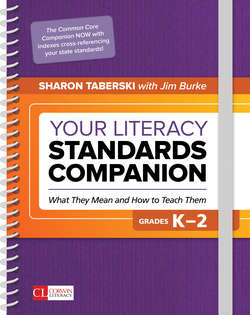Читать книгу Your Literacy Standards Companion, Grades K-2 - Jim Burke - Страница 9
На сайте Литреса книга снята с продажи.
Five Principles Behind the Teaching Ideas in This Book
ОглавлениеJim Burke, ever wise, cautioned me that the function of Your Literacy Standards Companion is to assist educators in the task of accurately knowing the intention of each standard and developing teaching ideas that will enable students to meet each one. Period. Therefore, I have tried to refrain from interpreting the standards, adapting them, or embedding them in too detailed a set of beliefs and practices, because the standards need to succeed in many different kinds of classroom settings, from ones that use basals and other commercial programs to Montessori settings and everything in between. But, that said, I feel compelled to provide the briefest of contexts for the teaching ideas I share, so you will know where I am coming from. The following recommendations are those that I think stand the best chance of developing K–2 students into strategic, engaged learners.
1 Embrace the reading workshop and writing workshop and its many opportunities to balance and differentiate instruction. Let’s face it, when we teach the whole class we’re teaching to the middle and leaving out the students at the top and bottom thirds of the class. The workshop model allows us to give all students what they need.
2 Let students do more of the heavy lifting. The brain that does the work is the brain that learns. I don’t know who first said, “The brain that does the work is the brain that learns,” but it’s been a mantra of mine for a few years now. We tend to do too much of the work for our students. We’re often inclined to ask leading rather than generative questions, and we frequently provide too little time for students to respond and work things out on their own.
3 Identify one or two practices that can make all the difference in the world and get really good at them. Rather than trying to get good at everything, focus on one or two instructional practices that are likely to bring about the greatest progress for students—practices that push students to “own” their learning.
4 Recognize that your goal is twofold: to help students read, write, think, and converse—and to teach them how to learn. In addition to reading for meaning, writing for real purposes, talking to and learning from one another with ears and eyes wide open, students need to learn how to learn.
5 Hold fast to what you know to be true about teaching and learning, and then follow the trail—instruction that matches your belief. There, I said it again: lean heavily on the standards and the teachings throughout this book, but at the end of the day, it’s you and your students and what helps them meet the expectations of the standards that matter most. To this end, I include a note at the bottom of each planning page that deserves attention here: “The standards guide instruction; they do not dictate it. So as you plan lessons, remember: you aren’t teaching the standards, but instead are teaching students how to read, write, talk, and think through well-crafted lessons that draw from the pedagogy embedded within them. Engaging lessons often have several ELA standards within them and integrate reading, writing, speaking and listening, and language.”
